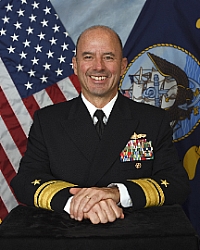ARLINGTON: Please bring the Navy all your good ideas, and please talk to us before you talk to Congress, service officials urged industry executives today. Under intense pressure to deliver faster, cheaper, and more innovative programs, the various factions of the Navy acquisition bureaucracy have labored mightily to coordinate more effectively, the senior officers said, and “stray voltage” from companies directly lobbying their members of Congress can short out the whole system.
“We’ve been on a journey with Congress to go faster. That requires some pretty specific synchronization and messaging and communication and, in fact, trust,” Rear Adm. James Kilby told the annual Surface Navy Association conference here. “From an industry perspective, calling us, engaging us, talking to us, and synchronizing that alignment can be most helpful. It can also be, frankly, harmful if the appropriators or the authorizers get some stray voltage that doesn’t match up to the story. They’re going to go to ‘all stop’ and they’re going to want to get to the bottom of it and figure it out.”
The 2019 budget actually allocates R&D funding for accelerated acquisition of urgently needed technologies of the Navy’s choice, Kilby said, rather than specifying every line item in law. That’s an extraordinary delegation of authority by the legislature, and the service doesn’t want anything to undermine Congress’s confidence.
As director of “warfare integration” at the Navy’s Pentagon HQ (staff section OPNAV N9I), Kilby bears a lot of the responsibility for coordinating Navy acquisition. “We’ve learned we can get out of synch,” he said. So he and the deputy assistant secretary for R&D, William Bray, now chair a monthly meeting of everyone from the Office of Naval Research to Program Executive Officers to OPNAV money men. “We review a quad chart for every program every month,” Kilby said, “and we discuss the specifics on that program, and then we communicate that at the appropriate level to the Hill so we can maintain alignment and intent.”
Acquisition Band Of Brothers
“We bring this band of brothers and sisters together and we say, what do we think is the best use of this enterprise’s accelerated acquisition capital?” said Rear Adm. Ronald Boxall, director of surface warfare (OPNAV N96) on the Navy HQ staff. “Things were moving so quickly,” he said, that different Navy organizations would brief Congress at “different times” and give legislators “different messages” about where any particular initiative stood. “I think this process has dramatically improved that, and if nothing else that’s I think the biggest value.”
The Navy’s come a long way, agreed Cmdr. Todd Philips of the Navy’s Appropriations Matters Office. “In my role as congressional liaison with the appropriation committees,” he said, “over those last few years, I’ve been part of the evolution of maritime accelerated acquisition as a process, and it’s evolved from PB17 [the presidential budget request for fiscal year 2017] where we had a miserable roll-out … to where we are today. And we had some bumps and bruises, but I really do think we’re in a much better place.”
One complication is the different perspectives on Capitol Hill between the armed services committees – which authorize programs to proceed under various legal authorities– and the appropriations committees – which must approve all actual funding. “On the one hand, the authorizers are asking the services to go faster, reform acquisitions, and they’ve given the authorities in Section 804 to do some of that work,” Philips said. “But on the other hand, the appropriators are still looking at everything through the same lens that they always have … They want to make sure that we’re using the dollars in an appropriate manner in the timeframe given. This is just a natural tension that exists in the defense committees, and it’s something that we as the … acquisition board are learning to navigate through.
“They are really interested in helping us,” Kilby said. “They have a specific role and we want to help them do that role, and transparency and clarity of communication collectively is very important.”
So how can industry help the Navy? There are plenty of ways to offer up new ideas, said deputy assistant secretary Bray. The service is using acquisition authorities new and old to create industry consortiums, public-private Cooperative Research & Development Agreements (CRDA), Small Business Innovation Research (SBIR) contracts, Broad Agency Announcements (BAAs) offering open-ended opportunities, and contracts under Other Transaction Authorities (OTAs) that streamline the regular procurement process.
“A compelling solution, when presented, will carry the day, so the entry point can be any and all of us,” said Rear Adm. David Hahn, who heads the Office of Naval Research. “We’ve got a BAA that’s on the street all the time [from] ONR, happy to hear what we have to say.”
“That signal of innovation from industry is always in the air, always in the air. and that’s where we’re here,” Boxall said. “We’re in this great power competition, we feel that industry’s going to bring us a lot of these solutions…. The demand for that’s gone up a lot.”
Just, please, talk to the Navy before you talk to Congress. “If you are an (accelerated) program and we are carrying your message to the Hill, we probably ought to make sure that we are all synchronized in what you’re saying and we’re saying,” Boxall said. “That’s more powerful.”
Major trends and takeaways from the Defense Department’s Unfunded Priority Lists
Mark Cancian and Chris Park of CSIS break down what is in this year’s unfunded priority lists and what they say about the state of the US military.






























